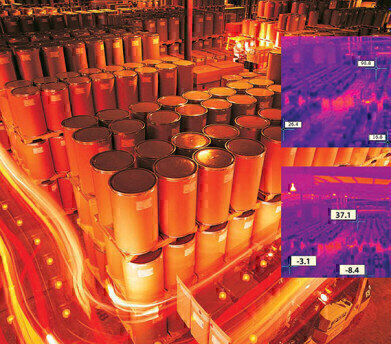Air Monitoring
Thermal imaging technology detects fires and saves lives and assets
Aug 16 2022
Teledyne FLIR’s, thermal imaging cameras help to prevent fires by detecting hot spots before they ignite. The automated, non-contact temperature measuring devices are ubiquitous in a host of industrial plants across the globe. Installing FLIR thermal imaging cameras to measure temperature changes automatically can help to avoid fire related disasters, creating a safer environment for both personnel and the local community whilst complying with insurance oversight. The FLIR A and A70 smart sensor cameras are widely used at fuel depots and provide, quick, precise and reliable early fire detection in all light conditions.
Warehouses are also highly likely to catch fire, even though a vast majority are fitted with fire alarms and firefighting systems. Teledyne FLIR’s thermal imaging cameras identify hot spots and provide operators with an early warning indication to evade full-on conflagration before a fire ignites. The compact and economical FLIR AX8 camera, with streaming video output, broadcasts data to a control room monitor that in turn sends personnel to the precise location of the hot spot. Operators can alter pre-set temperature alarms to compensate for temporary changes, for example: the presence of a worker, or a fork-lift truck. .
Another application example is the storage of flammable materials such as coal, wood chips and fertilisers, which face the risk of spontaneous combustion. In this case, a thermal imaging camera offers continuous, around-the-clock, remote temperature monitoring of these products when they are in a pile or being moved on a conveyor belt. The rugged and reliable FLIR FH-Series R multispectral fixed camera provides the perfect solution. The 4K visible imaging of the FH-Series R offers users quick hot spot verification and transmits images to an operator via a connected video management system (VMS) for instant assessment and response. The VMS can operate as part of a complete Teledyne FLIR or in combination with third-party solutions.
Bunker waste, like ‘pile’ applications, can be flammable when stored; self-combustion, heat development caused by pressure, methane gas accumulations and spontaneous chemical reactions between disposals can all potentially start a fire. Industrial locations such as municipal waste incinerators, foundries and cement plants can often opt to safeguard their assets and personnel using FLIR technology. Operators can network solutions such as FLIR’s A50 and A70 cameras, to offer a scalable system with high spatial resolution and thermal sensitivity.
Remote firefighters have found FLIR’s thermal imaging cameras to be extremely useful. Identifying a hot spot is only the start of a fire prevention solution, this is followed by remediation, which can be difficult in remote monitoring situations. FLIR cameras and software do not just locate hot spots, they can also set off an automated firefighting response, such as activating a sprinkler system, shutting a system down, or soaking the hot spot with firefighting foam - all via the Internet. For this application, FLIR offers the A310 ex ATEX-approved thermal imaging camera mounted in a flame-proof enclosure, with an integrated controller with digital I/O channels and sensors for temperature, humidity and pressure.
Digital Edition
AET 28.3 September 2024
September 2024
Business News - ENVEA announces acquisition of APAQ Group - SICK and Endress+Hauser sign strategic partnership - Efforts to curb gas flaring intensify amid environmental concerns Air Monito...
View all digital editions
Events
WEATHER • CLIMATE • WATER / EARTH OBSERVATIONS / GREEN ECONOMY
Oct 29 2024 St. Petersburg, Russia
Oct 30 2024 Hong Kong
Nov 05 2024 Toronto, Canada
Nov 05 2024 Rimini, Italy
Nov 06 2024 Ho Chi Minh City, Vietnam



















